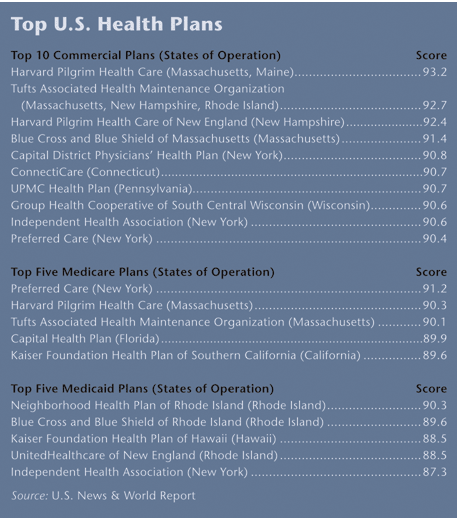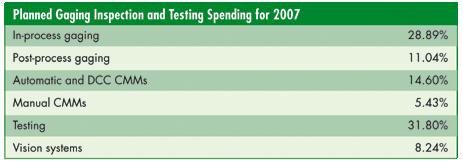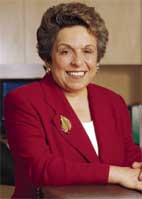 Top Health Plans Named Top Health Plans Named
Looking for new health insurance? You might want to consider some of the top health plans in the nation, as listed by the National Committee for Quality Assurance and U.S. News & World Report.
The organizations examined 684 health insurance plans from every state in the United States, reviewing their clinical performance, patient experience and satisfaction figures. NCQA accreditation status was a factor in the rankings, although NCQA media representative John Friedman reports that several of the top-rated plans are not NCQA-accredited.
Health plans in the Northeast fared particularly well in the rankings, with all but one of the top 10 commercial plans located in that region.
"Clearly, this is a trend in the data," says Friedman. "It's very clear that people in the Northeast have a lot of access to high-quality health care."
The top-rated commercial plan in the nation, Harvard Pilgrim Health Care, was awarded five (out of five possible) points for access to care, overall member satisfaction, illness and disease prevention, and patient treatment. It also enjoyed very high member-satisfaction ratings, with 79.9 percent of members giving a "high" rating to their personal doctor or nurse, and 87.5 percent giving a "high" rating to their health care in general. The industry average for these figures is 77.2 percent and 78.0 percent, respectively.
The top-rated Medicare plan, Preferred Care of New York, posted a high rate of preventive care, with 81.1 percent of patients receiving regular mammograms and 70.7 percent receiving colorectal cancer screening. The industry average for these statistics is 71.6 percent and 53.9 percent, respectively. Patients with Preferred Care plans also enjoy high rates of successful diabetes care: 95.9 percent had regular glucose testing (industry average: 88.9%) and 85.1 percent received regular eye exams (industry average: 66.5%).
"Millions of people will find this information useful in helping them select the right health plan for themselves and their families," says Margaret E. O'Kane, NCQA president. "Working with U.S. News allows us to not only identify those health plans that stand out, but also to motivate other plans to improve their performance and report on the results."
For more information, visit www.ncqa.org.

Do the Math!
Getting creative with math is never more prevalent than when someone is trying to make a point, hence the famous quote often attributed to Mark Twain: "There are three kinds of lies: lies, damned lies and statistics."
For at least a decade the following assertion has appeared in numerous articles, Web pages, speeches and even in an Environmental Protection Agency statement: "One gram of mercury can contaminate a 20-acre lake."
Enter "one gram of mercury can contaminate a 20-acre lake," without the quotes, into Google and you get about 78,000 hits. That's how prevalent this piece of information is.
Without going far into the history of this factoid, there is a very basic math error here. What is the error? Play "Do the Math" by sending us the correct answer, and we will enter you into a drawing to win an exciting (cheap, anyway) prize.
Our current winner is Stephen Brown, who was randomly selected from all entries with the correct answer to last month's riddle of ridiculous 'rithmetic:
"In December, Google had 16.5 trillion ad clickthroughs, compared with Yahoo's 9 trillion, according to Nielsen/NetRatings."
This paragraph from InformationWeek indicates that between Google and Yahoo, people clicked on advertisements 25.5 trillion times in December.
If you made the very generous assumption that half of Earth's 6.7 billion people are on the Internet eight hours a day, every day, they would each have to click on 30 ads every hour or one ad every two minutes. The word "trillion" should have been a clue to the author to check the facts.
Submit a math error that you've discovered to us using the comments link at the bottom of this page .
Statistically Speaking
Thinking about buying a gage? You're not alone.
U.S. manufacturers will spend close to $18 billion for capital equipment in 2007, with 6.7 percent of that, or $1.2 billion, spent on gages, CMMs, and testing and vision systems, according to the 2007 Gardner Research Capital Spending Survey. The agency forecasts a 4-percent increase in machine-tool consumption next year and the stabilization of generalized capital spending, which follows three consecutive years of 20-percent growth in the market.
Gardner also forecasts that capital spending will be driven by automotive OEMs, and the aerospace, medical and energy sectors.
For more information, visit www.gardnerweb.com.

 Former Cabinet Secretary to Speak at ASQ World Conference Former Cabinet Secretary to Speak at ASQ World Conference
Donna Shalala, former U.S. Secretary of Health and Human Services, will deliver the keynote address at the American Society for Quality's 2007 World Conference.
Shalala will address the connection between strong leadership and quality at the event, which will be held April 30-May 2 at the Orange County Convention Center in Orlando, Florida. She will deliver her speech on the last day of the conference and also present the
2007 International Team Excellence Awards, which is always a highlight of the annual show.
Shalala is currently president of the University of Miami and was named as one of America's Top 25 Leaders by U.S. News & World Report in 2005. She served in President Clinton's cabinet for eight years, becoming the longest-serving health and human services secretary in U.S. history. Shalala was the first woman to be appointed to head a Big 10 school as chancellor of the University of Wisconsin, Madison; she also served as the director and treasurer of New York's Municipal Assistance Corp.
Jim Carroll, a futurist and innovation expert, will also address the 2007 World Conference. Carroll is a prolific speaker and author, and has been recognized for his critical thinking and business-oriented view of issues related to social, consumer and workplace trends. His blog ( www.jimcarroll.com/weblog) was cited in BusinessWeek's September "Inside Innovation" report.
The theme of the 2007 World Conference is "Fueling Innovation Through People and Quality." For more information, visit http://wcqi.asq.org.
 Harry Returns to Six Sigma Roots Harry Returns to Six Sigma Roots
Dr. Mikel Harry, the man widely credited with shaping Six Sigma into its current operational state, has returned to the consultancy he founded 12 years ago.
Harry reports that he left Six Sigma Academy in 2001 with the intent to retire and work on philanthropic and part-time business activities. He developed Six Sigma training materials for Arizona State University's online Six Sigma certification program and created a methodology he calls IRCA (for innovate, realize, configure and attenuate), but he missed working every day.
"It was fun for a year or so, but after that, I found I got a little bored," says Harry. "I didn't know how much I would miss the creative stimulation you get from working in an office every day."
He returns as SSA's vice chairman and chief knowledge officer, the title he had before he left the company. Harry's return marks a multiyear effort to advance the organization's lean and Six Sigma processes. It will also allow SSA and Harry's Six Sigma Management Institute--which he founded in 2003--to work more closely together, although the exact working partnership between the organizations is still being discussed.
"It's a wonderful feeling to be reconnected to SSA," says Harry. "Our reunion has created a super opportunity to develop new and innovative ways to create value, especially for those corporate leaders that seek to push the envelope of business performance."
SSA is located in Scottsdale, Arizona. For more information, visit www.6-sigma.com.
 Bingo! Bingo!
Let's face it: Quality improvement is imperative, but sifting through piles of statistical figures and explaining cause rates, defect rates, et al. to shop floor workers can be a little, dare we say, boring.
Here's a good idea to make quality fun, visible and interactive, courtesy of Stoesser-Gordon Plastics Inc., a Santa Rosa, California-based medical device manufacturer. The ISO 900 1- and ISO 13485-registered company gives each employee--temporary and regular, with the exception of top management--a bingo card. For each day with no accidents, the accounting office draws a number. Employees can win three ways: single lines are worth $25 cash, a "safety cross" or all corners is worth $30 cash, and a blackout wins the employee $200 in cold, hard cash.
The company reports that the program has been extraordinarily effective in reducing accidents and has significantly reduced its worker's comp costs.
For more information, visit www.sgplastics.com.
'Healthy' Accreditation
A federal committee has recommended the adoption of a national accreditation model for public health agencies in the United States.
The National Association of County and City Health Officials and the Association of State and Territorial Health Officials have been discussing the formation of a national accreditation model for the approximately 3,000 public health agencies in the United States. The topic was first broached in a 2002 Institute of Medicine report entitled "The Future of the Public's Health" that recommended an investigation into the feasibility of national accreditation for public health agencies. The formation of the Exploring Accreditation committee formalized the project last year, and the accreditation scheme is on track to be operational in three to four years, says Jessica Solomon, NACCHO program director.
The accreditation program is still being developed, and it is expected to include standards tailored to public health organizations' needs, and emphasize continuous improvement. Conformity assessment will likely follow the ISO 9001 model, with applicants performing a readiness review and self- assessment prior to a formal site visit from auditors. The program will be voluntary.
"This is a historic day for public health in America," says Kaye Bender, steering committee chair and dean of the school of nursing at the University of Mississippi Medical Center, when announcing the steering committee's recommendation.
The Exploring Accreditation steering committee recommended the formation of a national nonprofit organization to oversee and administer the accreditation scheme.
Public health agencies perform various health-related tasks, such as restaurant inspections, clinical services and vaccination administration, infectious disease monitoring, environmental-health testing, regional emergency-preparedness response and training, and public-health reporting.
The Exploring Accreditation project was funded by the Robert Wood Johnson Foundation and the Centers for Disease Control and Prevention.
For more information, visit www.exploringaccreditation.org.
ANAB Trademark Lawsuit Still in Dispute
A complex and long-running lawsuit alleging trademark infringement--among a host of other complaints--is still working its way through the federal district court system.
The Registrar Accreditation Board (which became the ANSI-RAB National Accreditation Program--ANAB--in 2005) filed suit against Stephen Keneally and his American Global Standards registrar company in 2003 over Keneally's use of RAB's logo on approximately 95 Japanese certifications to ISO 9001.
In February 2003, RAB revoked AGS' accreditation after an audit of the company revealed several noncompliances. Keneally argues that the cited items weren't valid and refused to comply with the RAB's "completely unrealistic" demands to maintain his accreditation. With his RAB accreditation gone, almost 100 of Keneally's Japanese clients stood to lose their newly issued, RAB-accredited registrations to ISO 9001.
Thus, in April Keneally made arrangements with another RAB-accredited registrar, American Institute of Quality Registrars, to re-issue the disputed registrations. The new certificates indicated that the recipient received ISO 9001 registration from AIQR "on behalf of AGS," and included RAB's trademarked logo.
Therein lies the legal dispute. In its suit, RAB argues that AGS deliberately misled its clients by including RAB's logo on the certificates, and lost the right to include any reference to RAB when it lost its RAB accreditation. Keneally, however, bitterly disputes the loss of his RAB accreditation. He was RAB-accredited for 10 years and alleges that RAB's lawsuit was an elaborate ruse to steal his clients borne out of a personal dispute. AIQR eliminated its certification agreement with AGS when RAB threatened its own accreditation, and AGS' clients with invalid registrations were transferred to another registrar, as dictated by RAB.
"If they don't like what you're doing, kiss your business goodbye because that's what they've done to me," says Keneally. "There is no impartial body in the system to resolve complaints. It's all dictated by [ANAB]."
Randy Dougherty, ANAB's director of accreditation, reports that he hopes the suit is settled quickly. The purpose of filing suit, he says, was simply to maintain the integrity of RAB accreditation for all registrars.
Dougherty says there have been settlement talks in the case, but Keneally is vowing to continue the legal battle until he is sufficiently reimbursed for his losses. He has filed a counter claim against ANAB and Dougherty personally, as well as two of his former business partners and AIQR, and says he has no intention of backing down.
 Ugh, I'm Really Sick Today Ugh, I'm Really Sick Today
The number of employees calling in sick to work is rising, and according to new research, most of them aren't truly sick.
The 2006 Unscheduled Absences Survey, conducted by CCH Inc., found that just one in three employees who called in sick this year did so because they were really sick. The other two did so for personal reasons. What were the real reasons? CCH reports that family issues made up for 24 percent of the absences, personal needs accounted for 18 percent, 12 percent reported being too stressed to work and 11 percent simply felt entitled to the unscheduled day off. The total cost of unscheduled absences to large companies was $850,000.
Absenteeism is a problem, but so is "presenteeism," or when sick workers come to work anyway. Fifty-six percent of employers reported that presenteeism is a problem for them, up from 48 percent in 2005 and 39 percent in 2004.
Employers are more flexible than ever, though, with their employees' work schedules. The average employer now offers 11 programs designed to help employees balance their work and family lives, as compared to nine in 2005. These programs include employee assistance plans (76%), leave for school functions (65%), wellness programs (67%), flu shot programs (64%) and alternative work arrangements (63%).
See the entire report at www.cch.com/absenteeism2006.
Survey Says...
An informal survey of approximately 2,600 ISO-registered companies found that registration to ISO 9001 provides a positive return on investment.
Respondents generally believe that their registrations have improved their internal and external company performance, and 84 percent reported a positive return on the financial investment made in registration. The survey was commissioned by the Independent Association of Accredited Registrars in cooperation with ANSI-ASQ National Accreditation Board (ANAB).
There are currently more than 800,000 ISO 9001-registered companies worldwide, including almost 50,000 in the United States.
For more information, visit www.anab.org.
|